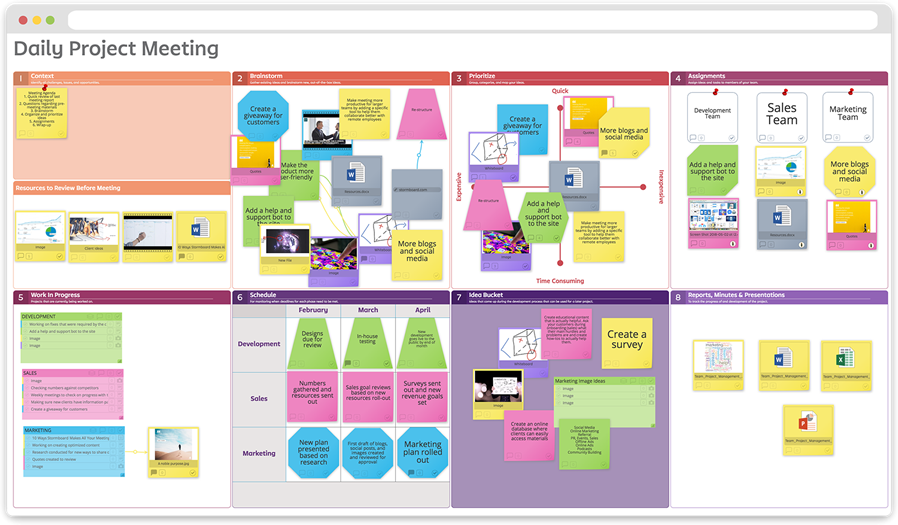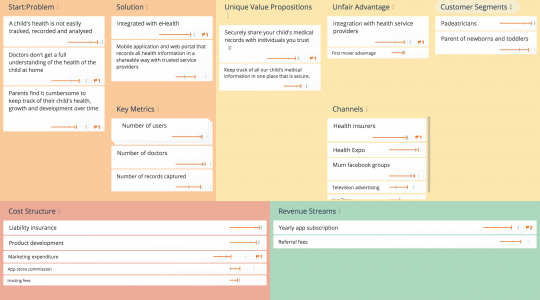
As the number of remote workers continues to skyrocket globally, dispersed teams need tools that support their need to collaborate. Powerful web-based visual collaboration tools have emerged as potent instruments for group brainstorming, sense-making and other popular business applications.
To help you better understand what tasks these tools are being used for and the benefits of doing so, I recently asked four of their developers to share their thoughts on these topics. This article is a consolidation of their responses.
The top 10 business applications of visual collaboration tools
- Brainstorming and capturing/organizing ideas
- Strategy mapping and road mapping
- Change management
- Meeting management
- Project management/task prioritization
- Analyzing, solving complex challenges
- Optimizing business processes and kanban
- Product planning and development
- Facilitated group discussion and problem solving
- Remote collaboration
How do visual collaboration tools benefit businesspeople?
Shared understanding: A shared visual environment enables tams to build shared understanding of the business challenge at hand. The visual format enables team leads and members to see relationships between pieces of information, uncover hidden ideas and opportunities and more. Once the team reaches consensus on a course of action, they can then use these tools to define, weight and assign tasks to team members.
Support for brainstorming processes: These visual collaboration tools not only enable teams and their facilitators to capture, organize and evaluate ideas. They also allow facilitators to set up multi-step brainstorming processes to generate and vet ideas.

Dot voting: When teams are brainstorming in person with Post-it! notes, dot voting is a popular technique for team members to anonymously declare which ideas they believe are the most promising. Some of these visual collaboration tools support dot voting functionality, scoring or other methods of weighting ideas. In all cases, the team’s goal is to identify a handful of ideas that meet its criteria for potential value (resources required, investment required, time required to develop it, degree of alignment with corporate goals, etc.).
From ideas to action: Visual collaboration tools enable teams to take the top ideas they’ve identified and build action plans around them, complete with task assignments.
Visual templates: Most of these applications include templates that can help teams get started faster on collaboration projects, and can simplify project reporting. These templates can also enforce consistency by utilizing your standardized business processes as the canvas upon which information is shared and updated.

Talking through sensitive issues: Change management and other far-reaching organizational initiatives require all stakeholders and staff to have an opportunity to “have their say” about their concerns, fears and hopes. A web-based visual collaboration tool gives them a palette where they can air their concerns anonymously. Management can group and organize responses to identify recurring themes, leading to deeper, more meaningful discussions of how to plan for change.
Anonymity aids introverts: Some of these applications enable team members to post their ideas and concerns anonymously. This ensures that introverts, whose opinions are tragically under-represented in most face-to-face planning meetings, get their say.
Support for a variety of thinking techniques: From mind maps and process flows to business model canvases and perceptual maps, these tools support expansive, divergent thinking – while also providing evaluation teams to converge around the best potential solutions. Many of the tools enable team members to attach comments to their colleagues’ ideas, providing highly targeted, in-context feedback.
Increase the efficiency of meetings: The team leader can help members prepare for meetings by creating a rich visual agenda, including links to files, relevant web content and other forms of context. Team leads can also populate a shared collaboration space with team “pre-work” or background materials, such as a SWOT analysis, Agile framework or Kanban board. With team members better prepared, the meeting itself can proceed more efficiently.
Share ideas any time, anywhere: Some of these visual collaboration tools enable sharing via mobile devices, enabling highly mobile team members to contribute asynchronously – when and where (and from the platform that’s) it’s most convenient for them.
Contribute ideas in a variety of formats: Some tools limit users to virtual Post-It notes, while others enable you to add ideas as text, videos, files, free-form drawings, images and other formats.
Road maps made easy: Some of these tools enable teams to lay out events and tasks on a timeline, making it easy to create and refine a visual road map of a project, initiative or new product. High-level goals, objectives and metrics can be placed within the same diagram, for added context.
Speed and flexibility are supported: Business today requires constant feedback from the market, which results in changes to plans. These visual collaboration tools can speed up the cycle from strategy to execution. You will never again have to do the tedious work of developing detailed plans in complex tools, only to have to redo them when you encounter new information. In that sense, they become “living” visual documents that can provide exceptional value and clarity to teams.
Conclusion
If your company uses remote teams and need a more efficient and effective way to collaborate, then you should definitely give visual collaboration tools a try.
Thank you to Stormboard, GroupMap, Cardsmith and Cardboardit, who contributed their visual collaboration tool expertise to this article.

Leave a Reply